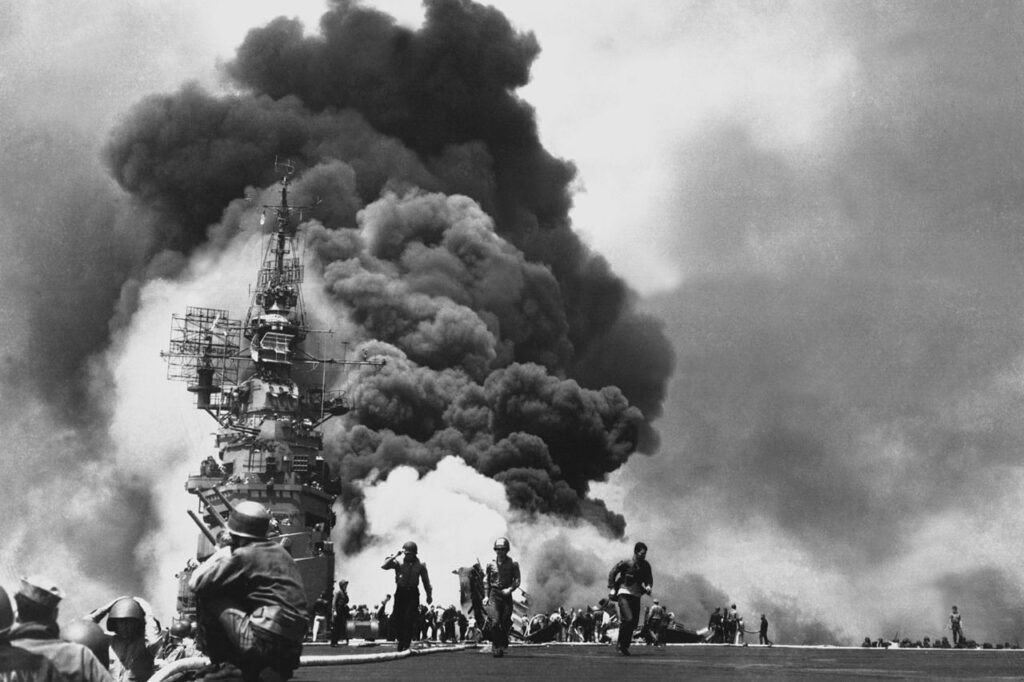The Battle of Okinawa, fought from April to June 1945, was a significant and bloody conflict of World War II. The United States targeted this strategic island due to its airfields, which could be used for bombing raids. The invasion was meticulously planned, with an enormous armada of naval vessels and a vast number of troops assembling for the assault. Kamikaze suicide attacks were employed on a large scale for the first time, causing damage and casualties. The fighting was brutal and relentless, with the Japanese defenders fighting fanatically. Tanks and aircraft played critical roles, but the terrain and tenacity of the Japanese presented challenges. The battle had a significant impact on the outcome of the war and influenced President Truman’s decision to use atomic bombs. The high casualties remind us of the cost of armed conflict.
The Battle of Okinawa: Bloodiest Conflict in the Pacific
Introduction
The Battle of Okinawa, fought from April to June 1945, was one of the most significant and bloodiest engagements of World War II. Situated in the Pacific theater, this battle marked the final phase of the United States’ campaign to capture the Japanese-held islands.
Background
By 1945, Japan was on the verge of defeat, with US forces continuously advancing in the Pacific. Okinawa, a strategic island located close to mainland Japan, became a prime target for the American forces due to its airfields, which could be used as bases for bombing raids.
Preparations for Battle
The Allied forces meticulously planned the invasion of Okinawa, assembling an enormous armada of naval vessels and an overwhelming number of troops. The US Navy’s Fifth Fleet, led by Admiral Raymond A. Spruance, and the Tenth Army, commanded by General Simon Bolivar Buckner Jr., were responsible for executing the assault.
The Battle Begins
On April 1, 1945, Easter Sunday, the amphibious assaults on Okinawa began. Over 180,000 troops stormed the island, meeting fierce resistance from the Japanese forces. As the US Army and Marine Corps fought their way ashore, they faced a torrent of artillery fire, heavy machine-gun emplacements, and kamikaze attacks.
Kamikaze Threat
The Battle of Okinawa is well-known for being the first battleground where the Japanese employed kamikaze suicide attacks on a large scale. The Japanese pilots, known as “Divine Wind,” crashed their planes loaded with explosives into Allied ships, causing significant damage and casualties.
Bloody Confrontation
The fighting on the island was brutal and relentless. The Japanese defenders, aware of the hopelessness of their cause, fought fanatically, preferring death over surrender. The terrain of Okinawa, with its numerous caves, underground tunnels, and fortified positions, presented a daunting challenge for the Allied forces.
Infantry and Artillery
The ground troops conducted arduous battles, moving inch by inch, house by house. The infantry faced significant challenges, including widespread booby traps, snipers, and the constant threat of ambush. Alongside the infantry, immense artillery barrages pounded the Japanese positions, further weakening their resistance.
The Role of Tanks and Aircraft
Tanks played a crucial role in the battle, providing mobile firepower and protection to the advancing troops. However, the terrain of Okinawa limited their effectiveness, as the rugged landscape hampered their mobility.
Additionally, aircraft played a vital role in the battle, attacking Japanese positions, attempting to neutralize the kamikaze attacks, and providing aerial support to the ground troops. Despite the air superiority of the Allied forces, the Japanese still managed to launch devastating aerial assaults.
Human Toll
The Battle of Okinawa took a heavy toll on both sides. The Japanese forces lost around 110,000–120,000 soldiers, with only a few hundred being captured. On the Allied side, the US suffered over 12,000 killed, while the Japanese inflicted significant casualties, including around 36,000 American wounded.
Impact and Legacy
The Battle of Okinawa had a tremendous impact on the outcome of World War II. It provided the Allies with a staging point for the subsequent invasion of mainland Japan, prompting the eventual surrender of Japan less than three months later after the atomic bombings of Hiroshima and Nagasaki.
Moreover, the battle made apparent the tenacity of the Japanese soldiers, foreshadowing the fierce resistance that would be faced during the anticipated invasion of mainland Japan. The high casualties suffered by the US forces at Okinawa influenced President Harry S. Truman’s decision to use atomic bombs to end the war swiftly.
Conclusion
The Battle of Okinawa stands as one of the bloodiest conflicts in the Pacific, epitomizing the intensity and ferocity of World War II. The battle was a critical turning point in the Pacific theater, setting the stage for the ultimate defeat of Japan and the end of the war. The sacrifices made by both sides serve as a sobering reminder of the high costs of armed conflict.
